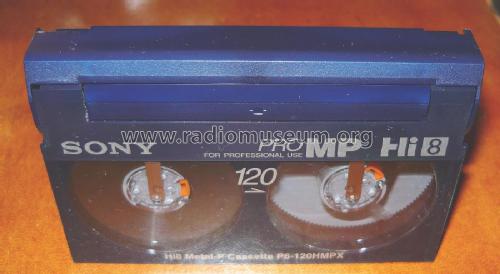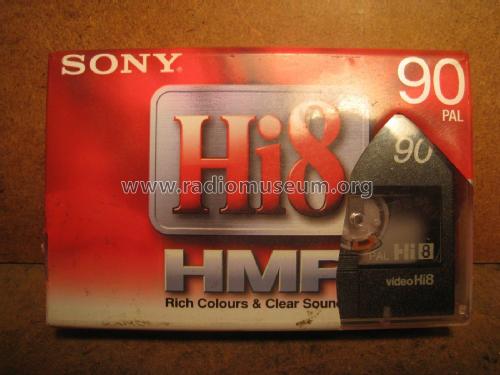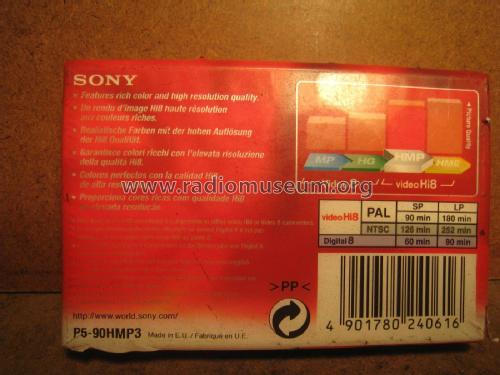Hi8 - 8mm Video Cassette All
Sony Corporation; Tokyo
- Country
- Japan
- Manufacturer / Brand
- Sony Corporation; Tokyo
- Year
- 1989 ??
- Category
- Miscellaneous (Other, Various) - see notes
- Radiomuseum.org ID
- 278814
- Wave bands
- - without
- Details
- Special Tape or Cassette-Format
- Power type and voltage
- No Power needed
- Material
- Plastics (no bakelite or catalin)
- from Radiomuseum.org
- Model: Hi8 - 8mm Video Cassette [All] - Sony Corporation; Tokyo
- Shape
- Miscellaneous shapes - described under notes.
- Dimensions (WHD)
- 98 x 64 x 17 mm / 3.9 x 2.5 x 0.7 inch
- Notes
-
This page is for all SONY labeled Hi 8 type Video Cassette tapes for all TV standards.
Please do not modify this page. You can specify additional data in the picture legend!
Bitte nur Bilder hochladen, alle Informationen/Daten in die Bildlegende.
History (taken from Wikipedia):
To counter the introduction of the Super-VHS format, Sony introduced Video Hi8 (short for high-band Video8). Like S-VHS, Hi8 used improved recorder electronics and media formulation to increase the recorded bandwidth of the luminance signal. Both Hi8 and S-VHS were officially rated at a luminance resolution of 400 lines, a vast improvement from their respective base formats and are roughly equal to laserdisc quality. Chroma resolution for both remain unchanged.
Both S-VHS and Hi8 retained the audio recording systems of their base formats; VHS HiFi Stereo outperformed Video8/Hi8 AFM, but remained restricted to high-end machines. In the late 1980s, digital (PCM) audio was introduced into some higher grade models of Hi8 (but never S-VHS) recorders. Hi8 PCM audio operated at a sampling rate of 32 kHz with 8-bit samples—higher fidelity than the monaural linear dubbing offered by VHS/S-VHS, but vastly inferior to VHS HiFi. PCM-capable Hi8 recorders could simultaneously record PCM stereo in addition to the legacy (analog AFM) stereo audio tracks.
The final upgrade to the Video8 format came in 1998, when Sony introduced XR capability (extended resolution). Video8-XR and Hi8-XR offered a modest 10% improvement in luminance detail. XR equipment replays non-XR recordings well, and XR recordings are fully playable on non-XR equipment, though without the benefits of XR.
All Hi8 equipment can record and play in the legacy Video8 format. The reverse was not usually the case though there were a few late entry Video8 systems that would recognize and play Hi8 recordings.
- Net weight (2.2 lb = 1 kg)
- 0.085 kg / 0 lb 3 oz (0.187 lb)
- Author
- Model page created by Edoardo Sigismondo. See "Data change" for further contributors.
- Other Models
-
Here you find 4067 models, 3924 with images and 975 with schematics for wireless sets etc. In French: TSF for Télégraphie sans fil.
All listed radios etc. from Sony Corporation; Tokyo
Collections
The model Hi8 - 8mm Video Cassette is part of the collections of the following members.











